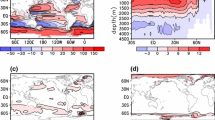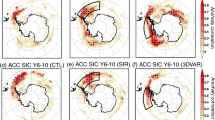Abstract
In projections of twenty-first century climate, Arctic sea ice declines and at the same time exhibits strong interannual anomalies. Here, we investigate the potential to predict these strong sea-ice anomalies under a perfect-model assumption, using the Max-Planck-Institute Earth System Model in the same setup as in the Coupled Model Intercomparison Project Phase 5 (CMIP5). We study two cases of strong negative sea-ice anomalies: a 5-year-long anomaly for present-day conditions, and a 10-year-long anomaly for conditions projected for the middle of the twenty-first century. We treat these anomalies in the CMIP5 projections as the truth, and use exactly the same model configuration for predictions of this synthetic truth. We start ensemble predictions at different times during the anomalies, considering lagged-perfect and sea-ice-assimilated initial conditions. We find that the onset and amplitude of the interannual anomalies are not predictable. However, the further deepening of the anomaly can be predicted for typically 1 year lead time if predictions start after the onset but before the maximal amplitude of the anomaly. The magnitude of an extremely low summer sea-ice minimum is hard to predict: the skill of the prediction ensemble is not better than a damped-persistence forecast for lead times of more than a few months, and is not better than a climatology forecast for lead times of two or more years. Predictions of the present-day anomaly are more skillful than predictions of the mid-century anomaly. Predictions using sea-ice-assimilated initial conditions are competitive with those using lagged-perfect initial conditions for lead times of a year or less, but yield degraded skill for longer lead times. The results presented here suggest that there is limited prospect of predicting the large interannual sea-ice anomalies expected to occur throughout the twenty-first century.











Similar content being viewed by others
References
Arzel O, Fichefet T, Goosse H (2005) Sea ice evolution over the 20th and 21st centuries as simulated by current AOGCMs. Ocean Model 12:401–415. doi:10.1016/j.ocemod.2005.08.002
Bader J, Mesquita MDS, Hodges KI, Keenlyside N, Østerhus S, Miles M (2011) A review on northern hemisphere sea-ice, storminess and the North Atlantic Oscillation: observations and projected changes. Atmospheric Research 101(4):809–834. doi:10.1016/j.atmosres.2011.04.007
Bengtsson L, Semenov VA, Johannessen OM (2004) The early twentieth-century warming in the Arctic—a possible mechanism. J Clim 17:4045–4057. doi:10.1175/1520-0442(2004)017<4045:TETWIT>2.0.CO;2
Blanchard-Wrigglesworth E, Armour KC, Bitz CM, DeWeaver E (2011) Persistence and inherent predictability of Arctic sea ice in a GCM ensemble and observations. J Clim 24:231–250. doi:10.1175/2010JCLI3775.1
Blanchard-Wrigglesworth E, Bitz CM, Holland MM (2011) Influence of initial conditions and climate forcing on predicting Arctic sea ice. Geophys Res Lett 38:L18,503. doi:10.1029/2011GL048807
Boé JL, Hall A, Qu X (2009) September sea-ice cover in the Arctic Ocean projected to vanish by 2100. Nat Geosci 2(5):341–343
Box GEP, Jenkins GM, Reinsel GC (2008) Time series analysis: forecasting and control. Wiley series in probability and statistics. Wiley, New York
Branstator G, Teng HY (2010) Two limits of initial-value decadal predictability in a CGCM. J Clim 23(23):6292–6311. doi:10.1175/2010JCLI3678.1
Brovkin V, Raddatz T, Reick CH, Claussen M, Gayler V (2009) Global biogeophysical interactions between forest and climate. Geophys Res Lett 36:L07,405. doi:10.1029/2009GL037543
Francis JA, Vavrus SJ (2012) Evidence linking arctic amplification to extreme weather in mid-latitudes. Geophys Res Lett 39:L06,801. doi:10.1029/2012GL051000
Goosse H, Arzel O, Bitz CM, de Montety A, Vancoppenolle M (2009) Increased variability of the Arctic summer ice extent in a warmer climate. Geophys Res Lett 36:L23,702. doi:10.1029/2009GL040546
Hermanson L, Sutton RT (2009) Case studies in interannual to decadal climate predictability. Clim Dyn. doi:10.1007/s00382-009-0672-y
Hibler WD III (1979) A dynamic thermodynamic sea ice model. J Phys Oceanogr 9(4):815–846
Holland MM, Bitz CM, Tremblay B (2006) Future abrupt reductions in the summer Arctic sea ice. Geophys Res Lett 33:L23,503. doi:10.1029/2006GL028024
Holland MM, Bailey DA, Vavrus S (2011) Inherent sea ice predictability in the rapidly changing Arctic environment of the Community Climate System Model, version 3. Clim Dyn 36:1239–1253. doi:10.1007/s00382-010-0792-4
Honda M, Inoue J, Yamane S (2009) Influence of low Arctic sea-ice minima on anomalously cold Eurasian winters. Geophys Res Lett 36:L08,707. doi:10.1029/2008GL037079
Jolliffe, IT, Stephenson, DB (eds) (2012) Forecast verification: a practicioner’s guide in atmospheric science. Wiley-Blackwell, Oxford
Jungclaus JH, Fischer N, Haak H, Lohmann K, Marotzke J, Matei D, Mikolajewicz U, Notz D, von Storch J (2013) Characteristics of the ocean simulations in MPIOM, the ocean component of the MP Earth System Model. J Adv Model Earth Syst (accepted)
Kauker F, Kaminski T, Karcher M, Giering R, Gerdes R, Vossbeck M (2009) Adjoint analysis of the 2007 all time Arctic sea-ice minimum. Geophys Res Lett 36:L03,707
Kay JE, Holland MM, Jahn A (2011) Inter-annual to multi-decadal Arctic sea ice extent trends in a warming world. Geophys Res Lett 38:L15,708. doi:10.1029/2011GL048008
Koenigk T, Mikolajewicz U (2008) Seasonal to interannual climate predictability in mid and high northern latitudes in a global coupled model. Clim Dyn 32(6):783–798. doi:10.1007/s00382-008-0419-1
Marsland SJ, Haak H, Jungclaus JH, Latif M, Röske F (2003) The Max-Planck-Institute global ocean/sea ice model with orthogonal curvilinear coordinates. Ocean Model 5:91–127
Matei D, Baehr J, Jungclaus JH, Haak H, Muller WA, Marotzke J (2012) Multiyear prediction of monthly mean atlantic meridional overturning circulation at 26.5 degrees N. Science 335(6064):76–79. doi:10.1126/science.1210299
Mauritsen T, et al (2012) Tuning the climate of a global model. J Adv Model Earth Syst. doi:10.1029/2012MS000154
Meinshausen M, Smith SJ, Calvin K, Daniel JS, Kainuma MLT, Lamarque J, Matsumoto K, Montzka SA, Raper SCB, Riahi K, Thomson A, Velders GJM, van Vuuren DPP (2011) The RCP greenhouse gas concentrations and their extensions from 1765 to 2300. Clim Chang 109(1):213–241 URL http://www.scopus.com
Notz D (2009) The future of ice sheets and sea ice: between reversible retreat and unstoppable loss. Proc Nat Acad Sci USA 106(49):20,590–20,595. doi:10.1073/pnas.0902356106
Notz D, Haumann FA, Haak H, Jungclaus JH, Marotzke J (2013) Arctic sea-ice evolution as modeled by MPI-ESM. J Adv Model Earth Syst (accepted) doi:10.1002/jame.20016, URL http://onlinelibrary.wiley.com/doi/10.1002/jame.20016/abstract
Ogi M, Rigor IG, McPhee MG, Wallace JM (2008) Summer retreat of Arctic sea ice: role of summer winds. Geophys Res Lett 35(24):L24,701. doi:10.1029/2008GL035672
Pohlmann H, Botzet M, Latif M, Roesch A, Wild M, Tschuck P (2004) Estimating the decadal predictability of a coupled AOGCM. J Clim 17:4463–4472
Raddatz TJ, Reick CH, Knorr W, Kattge J, Roeckner E, Schnur R, Schnitzler KG, Wetzel P, Jungclaus J (2007) Will the tropical land biosphere dominate the climate–carbon cycle feedback during the twenty-first century. Clim Dyn 29(6):565–574. doi:10.1007/s00382-007-0247-8
Roeckner E, Buml G, Bonaventura L, Brokopf R, Esch M, Giorgetta M, Hagemann S, Kirchner I, Manzini LKE, Rhodin A, Schlese U, Schulzweida U, Tompkins A (2003) The atmospheric general circulation model ECHAM5. Tech. Rep. 349, Max Planck Institute for Meteorology, Hamburg
Semtner AJ (1976) A model for the thermodynamic growth of sea ice in numerical investigations of climate. J Phys Oceanogr 6:379–389
Shepherd TG, Arblaster JM, Bitz CM, Furevik T, Goosse H, Kattsov VM, Marshall J, Ryabinin V, Walsh JE (2011) Report on WCRP workshop on seasonal to multi-decadal predictability of polar climate (Bergen, Norway, 25–29 October 2010). SPARC Newsletter no. 36:11–19, URL http://www.atmosp.physics.utoronto.ca/SPARC/sparcnewsletter36.pdf
Stevens B, Giorgetta M, Esch M, Mauritsen T, Crueger T, Rast S, Salzmann M, Schmidt H, Bader J, Block K, Brokopf R, Fast I, Kinne S, Kornblueh L, Lohmann U, Pincus R, Reichler T, Roeckner E (2013) The atmospheric component of the MPI-M earth system model: ECHAM6. J Adv Model Earth Syst. doi:10.1002/jame.20015, URL http://onlinelibrary.wiley.com/doi/10.1002/jame.20015/abstract
Taylor KE, Stouffer RJ, Meehl GA (2012) An overview of CMIP5 and the experiment design. Bull Am Meteor Soc 93(4):485–498. doi:10.1175/BAMS-D-11-00094.1
Tietsche S, Notz D, Jungclaus JH, Marotzke J (2011) Recovery mechanisms of Arctic summer sea ice. Geophys Res Lett 38:L02,707. doi:10.1029/2010GL045698
Tietsche S, Notz D, Jungclaus JH, Marotzke J (2013) Assimilation of sea-ice concentration in a global climate model—physical and statistical aspects. Ocean Sci 9:19–36 doi:10.5194/os-9-19-2013, URL http://www.ocean-sci.net/9/19/2013/os-9-19-2013.html
von Storch H, Zwiers FW (1999) Statistical analysis in climate research. Cambridge University Press, Cambridge
Wetzel P, Winguth A, Maier-Reimer E (2005) Sea-to-air CO2 flux from 1948 to 2003: a model study. Global Biogeochemical Cycles 19(2):GB2005. doi:10.1029/2004GB002339
Woodgate RA, Weingartner T, Lindsay R (2010) The 2007 Bering Strait oceanic heat flux and anomalous Arctic sea-ice retreat. Geophys Res Lett 37:L01,602. doi:10.1029/2009GL041621
Acknowledgments
We thank all colleagues in Hamburg developing MPI-ESM and performing the CMIP5 simulations for technical support of this study at an early stage of model dissemination. We also thank two anonymous reviewers for thoughtful comments that helped to improve the manuscript. This work was supported by the Max Planck Society for the Advancement of Science and the International Max Planck Research School on Earth System Modelling. All simulations were performed at the German Climate Computing Center (DKRZ) in Hamburg, Germany.
Author information
Authors and Affiliations
Corresponding author
Electronic supplementary material
Below is the link to the electronic supplementary material.
382_2013_1698_MOESM1_ESM.eps
Supplementary material 1. Present-day case study: Characterization of the distribution of annual mean sea-ice extent predicted by the ensembles (compare Figure 8 of the manuscript). The reference run is given by the solid line with filled circles. The box plots have the ensemble median as their central value, the upper and lower quartile as box boundaries, and the ensemble minimum/maximum as whiskers. The climatological mean is indicated by a thick dashed line, and the climatological standard deviation by thin dashed lines. The title of the subplots denotes the prediction experiment shown: “LP” for lagged-perfect initial conditions or “SA” for sea-ice assimilated initial conditions, followed by the start month of the prediction experiment. (EPS 316 kb)
382_2013_1698_MOESM2_ESM.eps
Supplementary material 2. Mid-century case study: Characterization of the distribution of annual mean sea-ice extent predicted by the ensembles (compare Figure 8 of the manuscript). The reference run is given by the solid line with filled circles. The box plots have the ensemble median as their central value, the upper and lower quartile as box boundaries, and the ensemble minimum/maximum as whiskers. The climatological mean is indicated by a thick dashed line, and the climatological standard deviation by thin dashed lines. The title of the subplots denotes the prediction experiment shown: ``LP'' for lagged-perfect initial conditions or ``SA'' for sea-ice assimilated initial conditions, followed by the start month of the prediction experiment. (EPS 398 kb)
Rights and permissions
About this article
Cite this article
Tietsche, S., Notz, D., Jungclaus, J.H. et al. Predictability of large interannual Arctic sea-ice anomalies. Clim Dyn 41, 2511–2526 (2013). https://doi.org/10.1007/s00382-013-1698-8
Received:
Accepted:
Published:
Issue Date:
DOI: https://doi.org/10.1007/s00382-013-1698-8




